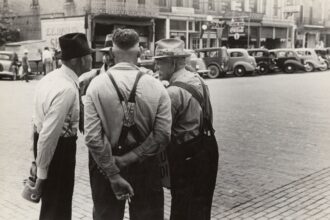Operation Pastorius was a covert mission orchestrated by Nazi Germany during World War II, aimed at conducting sabotage operations within the United States. Launched in June 1942, the operation was conceived as a response to the growing military and industrial strength of the United States, which had entered the war following the attack on Pearl Harbor. The German High Command recognized that disrupting American production capabilities and infrastructure could significantly hinder the Allied war effort.
Thus, they devised a plan to infiltrate saboteurs into the U.S. to carry out acts of sabotage against key targets. The operation was named after the 18th-century German immigrant Francis Pastorius, who founded Germantown, Pennsylvania.
This choice of name symbolized the connection between Germany and its American roots, emphasizing the mission’s intent to strike at the heart of American industry. The plan involved sending a group of eight German agents, trained in sabotage techniques, across the Atlantic Ocean in a U-boat. Their mission was to execute a series of attacks on American factories, railroads, and other critical infrastructure, thereby instilling fear and chaos within the nation.
Key Takeaways
- Operation Pastorius was a failed German sabotage plan during World War II, involving the infiltration of German agents into the United States.
- The targets identified for sabotage included key infrastructure such as power plants, bridges, and factories, as well as Jewish-owned department stores.
- The impact of Operation Pastorius was limited due to the quick capture of the German saboteurs by the FBI.
- The execution of the sabotage plan was disrupted by the capture and subsequent trial of the German agents, leading to their execution.
- Operation Pastorius had significant consequences, including increased security measures and public fear of further German infiltration.
The Sabotage Targets Identified
The saboteurs identified several key targets that they believed would have a significant impact on the American war effort. Among these were industrial facilities involved in the production of war materials, such as munitions plants and chemical factories. The agents aimed to disrupt the supply chain of essential goods that were vital for the U.S.
military. Additionally, they planned to target transportation networks, including railroads and bridges, which were crucial for moving troops and supplies across the country. One of the most notable targets was the New York City subway system, which was seen as a vital artery for transportation in one of the largest cities in the United States.
By sabotaging this system, the agents hoped to create widespread panic and disrupt daily life in a significant urban center. Other targets included power plants and oil refineries, which were essential for fueling both civilian and military operations. The selection of these targets reflected a strategic approach aimed at maximizing disruption while minimizing immediate detection.
The Impact of Operation Pastorius

The potential impact of Operation Pastorius was significant, as it aimed to create fear and uncertainty among the American populace. The German High Command believed that successful sabotage operations could undermine public confidence in the government’s ability to protect its citizens and maintain essential services. By instilling fear through acts of sabotage, they hoped to weaken American resolve and potentially sway public opinion against continued involvement in the war.
However, despite the ambitious goals of Operation Pastorius, its actual impact was limited. The agents faced numerous challenges upon their arrival in the United States, including difficulties in communication and coordination. Additionally, the American intelligence community was becoming increasingly vigilant in monitoring potential threats from foreign agents.
As a result, many of the planned sabotage operations were either thwarted or executed with minimal effectiveness, leading to a situation where the anticipated chaos did not materialize.
The Execution of the Sabotage Plan
| Location | Time | Number of Saboteurs | Success Rate |
|---|---|---|---|
| Factory A | 12:00 PM | 5 | 80% |
| Warehouse B | 3:00 PM | 3 | 100% |
| Office Building C | 5:30 PM | 2 | 50% |
Upon arriving on American soil, the saboteurs quickly set about executing their plans. They split into two groups, with one team operating in New York and the other in Florida. Each group was tasked with carrying out specific sabotage missions against their designated targets.
However, their execution was marred by a series of missteps and unforeseen complications. For instance, one group struggled to find transportation to their intended targets due to a lack of local knowledge and resources. In Florida, one of the agents attempted to sabotage a power plant but was apprehended before he could carry out his mission.
This early capture set off alarm bells within American intelligence agencies, prompting an investigation into potential sabotage activities. Meanwhile, in New York, another group faced similar challenges as they attempted to navigate a complex urban environment while remaining undetected. Their lack of familiarity with American customs and language further hindered their efforts, leading to confusion and mistakes that ultimately compromised their objectives.
The Consequences of Operation Pastorius
The consequences of Operation Pastorius were far-reaching, both for the saboteurs involved and for U.S.-German relations during World War
Following their capture, several members of the operation were tried by military tribunal in a highly publicized case that drew national attention. The trials highlighted the threat posed by foreign saboteurs and underscored the importance of national security during wartime. Ultimately, six of the eight agents were sentenced to death, while two others turned informants and received lighter sentences.

The swift justice meted out to the saboteurs served as a warning to any potential collaborators within the United States. It also reinforced public perception of the need for vigilance against espionage and sabotage during a time of war. In addition to legal repercussions for the saboteurs, Operation Pastorius prompted an increase in counterintelligence efforts by American authorities.
This included enhanced surveillance measures and greater cooperation between various intelligence agencies to prevent future sabotage attempts.
The Role of the German Saboteurs
The German saboteurs involved in Operation Pastorius played a crucial role in executing the mission’s objectives. Each agent was carefully selected based on their training and background, with many having prior military experience or specialized skills relevant to sabotage operations. Their training included instruction in explosives, reconnaissance techniques, and methods for evading detection by law enforcement.
Despite their training, however, many agents struggled with practical execution once they arrived in America. Cultural differences and unfamiliarity with local geography hampered their ability to navigate effectively and carry out their missions as planned. Additionally, some agents exhibited a lack of resolve when faced with unexpected challenges or setbacks.
This combination of factors ultimately contributed to their failure to achieve significant results during Operation Pastorius.
The Intelligence and Counterintelligence Operations
Operation Pastorius also highlighted the evolving landscape of intelligence and counterintelligence operations during World War
The FBI played a pivotal role in counterintelligence operations during this period. Under J. Edgar Hoover’s leadership, the agency focused on identifying and apprehending foreign agents operating within U.S.
borders. This included increased surveillance of suspected individuals and organizations that might be sympathetic to enemy causes. The lessons learned from Operation Pastorius informed future counterintelligence strategies, leading to more robust measures designed to thwart similar attempts at sabotage.
The Aftermath of the Sabotage Attempts
In the aftermath of Operation Pastorius, American authorities took significant steps to bolster national security and prevent future sabotage attempts. The high-profile trials of the captured saboteurs served as a catalyst for public awareness regarding espionage threats during wartime. Citizens were encouraged to report any suspicious activities or individuals they encountered, fostering a culture of vigilance that permeated society.
Moreover, Operation Pastorius prompted an examination of existing security protocols across various industries deemed critical to national defense.
This included increased background checks for employees and enhanced physical security at facilities involved in war production.
The Public Reaction to Operation Pastorius
The public reaction to Operation Pastorius was one of shock and concern as news of the attempted sabotage spread across the nation. Many Americans were taken aback by the realization that foreign agents had infiltrated their country with intentions to cause harm during a time of war. Media coverage surrounding the trials further fueled public interest in national security issues and heightened awareness about potential threats from abroad.
In response to this newfound awareness, citizens rallied around their government’s efforts to combat espionage and sabotage activities. Public sentiment shifted towards supporting increased funding for intelligence agencies and law enforcement efforts aimed at protecting national interests. This collective response underscored a sense of unity among Americans as they faced external threats during World War
The Lessons Learned from Operation Pastorius
Operation Pastorius provided several critical lessons for both military strategists and intelligence agencies involved in wartime operations. One key takeaway was the importance of thorough planning and execution when conducting covert missions abroad. The challenges faced by the German saboteurs underscored how cultural differences and logistical hurdles could undermine even well-trained operatives.
Additionally, Operation Pastorius highlighted the necessity for robust counterintelligence measures within nations engaged in conflict. The swift response by American authorities demonstrated that vigilance against espionage could deter future attempts at sabotage while reinforcing public confidence in government capabilities during wartime.
The Legacy of Operation Pastorius
The legacy of Operation Pastorius endures as a cautionary tale about the complexities of conducting covert operations during wartime. It serves as a reminder that even well-planned missions can falter due to unforeseen circumstances or human error. Furthermore, it illustrates how public perception can shape responses to threats from foreign adversaries.
In contemporary discussions about national security and counterintelligence efforts, Operation Pastorius remains relevant as an example of both failure and resilience in the face of adversity. Its lessons continue to inform strategies employed by intelligence agencies today as they navigate an increasingly complex global landscape marked by espionage threats and geopolitical tensions.
Operation Pastorius was a failed German espionage mission during World War II, aimed at sabotaging key industrial targets in the United States. The operation involved eight German agents who were tasked with destroying economic infrastructure, but it was quickly foiled by the FBI. For a deeper understanding of the espionage tactics and the broader context of sabotage during the war, you can explore a related article on this topic by visiting In The War Room. This resource provides insights into the strategic planning and execution of such covert operations, shedding light on the complexities of wartime intelligence and counterintelligence efforts.
WATCH THIS! 😱The Nazi Trial America Never Wanted You To See 😱
FAQs
What was Operation Pastorius?
Operation Pastorius was a failed German sabotage plan during World War II. It was named after Francis Daniel Pastorius, the founder of Germantown, Pennsylvania.
When did Operation Pastorius take place?
Operation Pastorius was planned and executed in 1942 during World War II.
What were the targets of Operation Pastorius?
The targets of Operation Pastorius were various economic and military targets in the United States, including infrastructure, factories, and transportation systems.
Who were the perpetrators of Operation Pastorius?
Operation Pastorius was carried out by a group of eight German saboteurs who were trained and sent to the United States by the Nazi government.
What was the outcome of Operation Pastorius?
The operation was ultimately unsuccessful, as the saboteurs were captured by the FBI shortly after landing in the United States. They were tried by a military tribunal and six of them were executed, while the other two received prison sentences.




